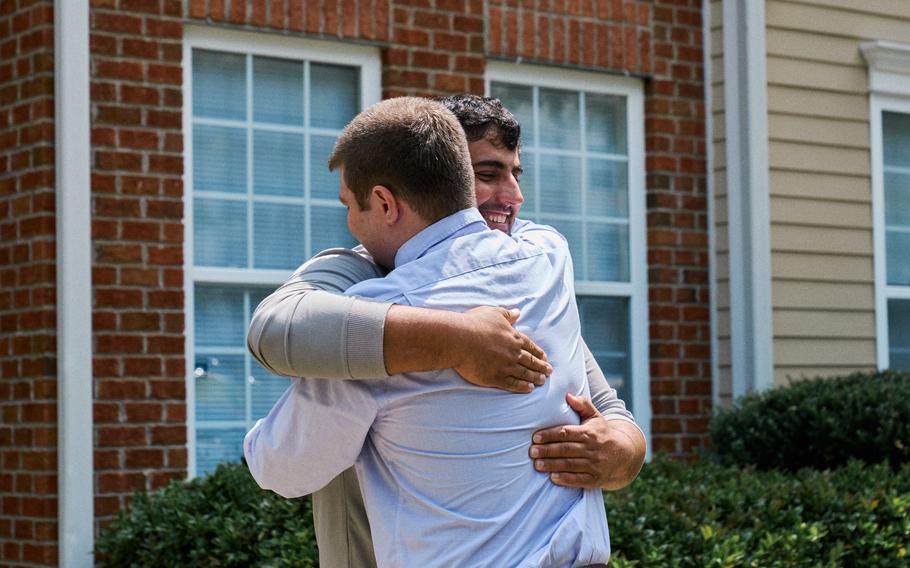
U.S. Army veteran Sean Halpin greets Esmatullah, a former liaison officer with the Afghan defense ministry whom he met in Kabul in 2019 and helped flee that country. (Jonathan Mehring/The Washington Post)
As Sean Halpin gears up every morning for the product marketing management he does from his Midlothian, Va., home, he also starts checking in with the 176 Afghan linguists and family members he tracks via a spreadsheet that he has carefully maintained for nearly three years. He wants to make sure those still awaiting a pathway out of Afghanistan are safe. He tries to boost spirits with his messages, adding funny memes and links to music like the theme song from “Rocky.”
When one of these contacts needs money for food or a sudden surgery, Halpin does his best to cover it from his own savings. The former Army intelligence officer estimates that he has spent some $400,000 on such emergencies since the U.S. military’s chaotic departure from Afghanistan in the waning days of August 2021. He even diverted the proceeds from a house sale in Texas, which were supposed to go toward his family’s new home in Virginia, and moved his wife and two children into an apartment. The decision nearly ended his marriage.
Helping the allies whom American troops left behind has never felt optional. Not for Halpin, nor for other veterans who continue to stand in the gap at significant personal and financial expense. Dozens of loosely formed volunteer organizations with names like Badger 6 and Heart of an Ace have emerged to coordinate the efforts.
What happened to those Afghans, in Halpin’s view, was “a soul-crushing betrayal.”
Yet with tens of thousands of people still thought to be at risk because of their past work for the United States, the veterans are taking stock. The nonprofit Operation Recovery this month launched a website, Impacts of War, a first-of-its-kind project that invites veterans to report their contributions of time and money to Afghan rescue and resettlement.
Elizabeth Lynn, an Air Force and Navy veteran who directs government relations for that group, says tallying up these donations and sacrifices is not merely about recording history. It’s about making U.S. government leaders understand what the cost of Afghanistan’s aftermath has been.
“I don’t think that they saw what the impact of the withdrawal was,” said Lynn, who has repeatedly wired her own money to the interpreter with whom she’d worked most closely during her deployment. “We need to hand it to them in black and white and say, ‘This is what the effect of the withdrawal had on our veterans and our civilians alike that worked there for years. This is the financial toll, in addition to the mental toll, the moral injury.’ That’s not free, because that comes at a cost, and the veterans felt obligated to pay, where the government didn’t.”
The State Department estimates that more than 120,000 Afghans have applied for the visas reserved for allies from that country, waiting 18 months on average to be processed.
Biden administration officials say their fate has not been forgotten. On Monday, the U.S. and Philippine governments announced an agreement to temporarily relocate Afghan allies to the relative safety of southeast Asia as they await visa adjudication. But given how modest the impact may be — initially affecting only 300 people — the veterans say their mission will continue.
Indeed, the vets’ sense of obligation seems to have no expiration date. They describe a complex, enduring guilt over a commitment they feel was broken.
“How do I put this thing down?” asks Peter Lucier, a Marine Corps veteran in St. Louis who has contributed to Afghan relocation efforts since the fall of Kabul. “Is there a graceful exit? How does this stop being a part of your life, because it can be so consuming? Or how do you find the balance with it?”
Some lawmakers are trying to begin making veterans financially whole from their Afghanistan outlays. The Ensuring Voluntary Actions are Compensated (EVAC) Act, a bill introduced last summer by Rep. Warren Davidson (R-Ohio), would allow any American “who expended personal funds to evacuate American citizens, lawful permanent residents of the United States, or Afghan allies from Afghanistan” to apply for reimbursement from the U.S. government.
The measure, which quickly passed in the House Foreign Affairs Committee but has yet to be brought to the House floor, only covers money spent between August and November 2021. While some veterans are skeptical that it will achieve its goal, Lee considers it a starting point in acknowledging the quiet work so many people have done.
Rep. Michael Waltz, a retired Green Beret who served early on in Afghanistan, has for almost two decades personally supported the family of an interpreter who died in his arms. The Florida Republican is perturbed by the costs veterans have borne.
“I talked to a gentleman who exhausted both of his children’s 529 [education savings] plans and his entire savings and is now in divorce because of it,” Waltz said at a roundtable before the committee in January. “But he can’t not answer the phone.”
In an interview this month, Waltz said he understood the sense of honor and duty that kept veterans footing visa application fees and rents for safe houses, even as donor funding to organizations supporting resettlement programs dried up and the U.S. government itself moved on.
Some administration officials, he added, still don’t grasp “the moral injury” that the veterans community suffered because of the military’s calamitous exodus.
Dave Hicks is a retired one-star Air Force general and founder of an organization that resettles and trains Afghan pilots after they arrive in this country. He has encountered numerous veterans who burned out emotionally after trying, at times futilely, to save their onetime Afghan partners.
The war’s aftermath exacerbated the trauma of combat, Hicks said. “It pulled a lot of those scabs off and reopened wounds.”

Halpin visits Esmatullah in a Midlothian, Va., apartment the former Afghan officer moved into in July. Halpin continues to help him set up a new life here, and the two men see each other regularly. (Jonathan Mehring/The Washington Post)
In Halpin’s last deployment to Afghanistan in 2019, he supervised nearly 200 Afghans as a linguist coordinator. The way he sees it, he was tasked with building friendships with the linguists as part of his military duty — and he represented America’s promise to them of protection and a pathway to the United States following their service.
Then came the desperate days as Air Force cargo jets took off from the Kabul airport. He fielded calls and texts from interpreters frantic over being left behind amid death threats from the Taliban.
“I felt betrayed,” said Halpin, who the following year resigned his commission in dismay. “The thing that resonated with me was, honor the promise, because there was a promise that was made.”
Most days now, he says, he spends hours during work lulls and down time sending messages and trying to troubleshoot issues that arise for his contacts in Afghanistan, from paperwork concerns to emergent medical needs. It’s the same on weekends and holidays, “including Christmas, including New Year’s, including when I’m at Disney World.”
Some 28 of the Afghan families on his spreadsheet have made it to the United States, and he’s been gratified to meet them and see them start afresh. Some, however, have been lost. The Taliban’s killing in April 2023 of former special forces commander Akmal Amir, one of the names on his list, was a jarring reminder of the perpetual danger.
Other veterans are working with Afghans who weren’t promised a special immigrant visa, typically referenced as SIV — a category created for civilians who assisted the U.S. military yet still are in danger because of their role.
Jim Papp, a retired Army helicopter pilot living in Montana, counted 18 names on his list at one point, all Afghan pilots whom he trained in Abu Dhabi as a U.S. government contractor. The foreign stamps in their passports, signifying their American-sponsored flight training, marked them as enemies to the Taliban.
This year, 14 of them have arrived in the United States via refugee visas. He hopes the remaining pilots will get approval before the year is out.
Papp estimates he’s spent $50,000 on visa fees, living expenses and even a safe house in Islamabad, Pakistan, where several babies have been born. And after three years of representing a tenuous thread of hope for these families — living off his retirement pay so he could send checks from his day job overseas — he looks forward to celebrating with them in person in Fort Worth, where most have opted to settle.
“I know these guys personally. They’re good people,” said Papp, who does mountain operations at a resort in Big Sky. “They represent the best that Afghanistan had to offer, educated progressives. When you work with them 18 months, and you know these guys, you’re just trying to make a difference, trying to save some lives.”